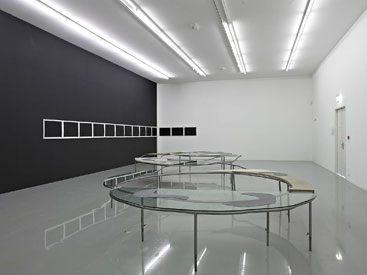
Born in 1925 in Milan (IT)
Died in 2003 in Turin (IT)

1984 (fruits et légumes) - 1992 (plomb)
Steel, glass, stones and lead
70 x 900 x 350 cm
Year of Purchase: 1992
As the father of Arte Povera, the Italian art movement that came into being in 1967, Mario Merz is among the major figures of 20th-century art. Metal, glass, stone, wood, and neons are all basic elements for the construction of Merz’s emblematic body of work, which mixes natural and industrial objects. The simple and essential forms of the spiral, igloo and cone complement the artist’s vocabulary, and his concerns go well beyond the arena earmarked for art. Merz attempts to rekindle the dialogue that has been broken off with nature, history, and memory, by making man his point of reference.
He also develops the theme of the table, as an extension of human labour. As a symbol of conviviality, the presence of man among men, the large open table summons food and proliferation. Like a seasonal table, the work receives the colourful fruit and vegetables of summer. The vegetables thus arranged are a metaphor of life and painting. At once a source of life and ephemeral food, vegetables and plants introduce the notion of the seasonal cycle and the extraordinary creative power of nature. Rhythm and alternation of colours and materials nevertheless re¬veal the notion of eternity which is taken up again by the form of the table as the mathematical sign for infinity. Its double round-ness incidentally sketches a dialogue with a sinuous and stratified Burgundian landscape. Like an image of an open space, the table is an undulating itinerary of half-moon shapes. Landscape-table, still-life-table, Merz’s offering-sculpture adopts the history of Western painting and makes the link with the generous depictions of Archimboldo.
Laden with sheets of lead randomly arranged, the table thus becomes a space of meditation, the transparency of the glass and the heavy and powerful presence of the lead converse with each other and reveal the stealthy presence of man in the universe. The wealth and simplicity of the forms and the scope of the subject lend this piece a force and a permanence which go well beyond discourse, and rediscover the symbolic sources of nature and human life.
Béatrice Josse